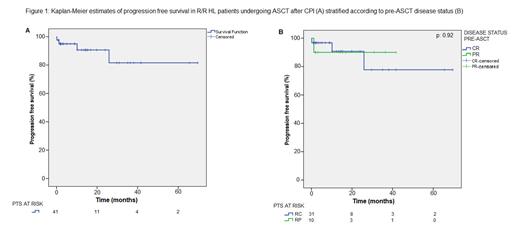CONCLUSIONS
Consolidation with autologous stem cell transplant (ASCT) in Hodgkin lymphoma (HL) was traditionally reserved for patients with chemosensitive disease. In 2021 a retrospective study showed encouraging results with ASCT consolidation after checkpoint inhibitors (CPI) in pts with relapsed/refractory (R/R) HL. Subsequently, several prospective studies with CPI +/- chemotherapy in 2nd line were published showing 1-year progression free survival (1-y PFS) rates of 90% but with increased incidence of engrafment syndrome.
We aimed to evaluate survival outcomes of consolidation with ASCT after CPI in our cohort of patients with R/R HL and the incidence of engrafment syndrome.
Patients with R/R HL who received consolidation with ASCT between 01/2016 and 5/2023 after treatment with CPI were included in this retrospective multicentric study. Descriptive statistics were used to summarize variables of interest. Progression free (PFS) and overall survival (OS) were estimated with Kaplan-Meier and variables were compared with log-rank test.
Forty-one patients from 15 transplant centers in Argentina were analyzed. The median age at ASCT was 31 years (19-60). High risk features were present in three quarters of patients, 23 (56%) with primary refractory disease and 8 (19.5%) with early relapse. Eighteen patients (43.9%) had ≥3 of the 5 pre-ASCT modified AETHERA high-risk factors. Patients received a median of 4 (2-6) systemic therapies before ASCT, including 27 patients previously treated with Brentuximab Vedotin (BV) to which 26 were refractory. Thirty-six patients (87.8%) received CPI monotherapy and 5 (12.2%) in combination with chemotherapy. Thirty-six (87.8%) underwent ASCT after CPI and 5 received additional treatment before transplant due to lack of response or progression. Patients received a median of 7 cycles (2-34) of CPI before ASCT. Complete metabolic (CMR) and partial remission (PMR) pre ASCT was documented in 31 (75.6%) and 10 (24.4%) patients, respectively). The median time from last dose of a CPI to ASCT was 60 days (3-183). The most utilized conditioning regimens were BEAM (22%), BEC (22%), BeEAM (7.2%) and CBV (48.8%). Median time to neutrophil engrafment was 11 days (8-15). Engrafment syndrome was observed in 14 (34.1%) with 10 patients requiring treatment with corticosteroids. Seven patients (17.1%) received post ASCT consolidation with either CPI or BV. After a median post ASCT follow up of 12.3 months, only 2 patients relapsed and 3 patients died (one of progressive disease, one of transplant related mortality and the other of a late infectious complication). Estimated 1-y PFS was 92.6% for the whole cohort, 93.5% and 90% for patients undergoing ASCT in CMR and in PMR, respectively, p: 0.92 (Figure 1). Patients requiring additional treatment after CPI had an estimated 1-y PFS of 80% vs. 94.4% in those undergoing ASCT straight after CPI, p: 0.38.
ASCT consolidation after CPI in this cohort of patients with high risk R/R HL was associated with very promising results even in those proceeding to ASCT in PMR. A third of the patients developed engrafment syndrome so it is important to be alert to the appearance of symptoms and evaluate early use of corticosteroids. Our findings are similar to the results of other studies and support ASCT consolidation in high-risk R/R HL patients receiving CPI.
Disclosures
No relevant conflicts of interest to declare.


